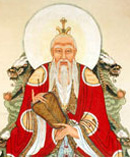
|
|
The Wise Seer of China—Laozi and the Tao-Te Ching The wise seer Laozi (Lao Tzu) lived in the capital city and served as the keeper of the archives at the royal court. As a man of great wisdom, he attracted many people, who gathered around him and considered him their teacher. But he was not pleased by the moral decay of the city and the kingdom. So he decided to leave. He traveled westward. His plan was to go beyond the country’s western border and there in the frontier, in solitude, spend the rest of his life. But when he reached the kingdom’s western gate, the guard recognized him. He entreated the wise man to set down a record of his wisdom before departing the country for good. Thus, according to legend, was born the Tao Te Ching (or Dao De Jing). Out of this great work emerged the philosophical and religious traditions known as Taoism (or Daoism), which have been such a powerful force in Eastern Asia for more than two millennia, and which have exerted their influence in the West for the last two centuries. I have been reading Laozi’s works for a number of years. I just finished reading a lesser-known book attributed to him called the Wenzi. It’s hard to imagine what life was like in China in the 6thcentury BC—2,600 years ago—when Laozi and his disciples lived. But his teachings could not be more relevant to our lives today. We know very little about Laozi. Some scholars believe the works attributed to him were written by a collection of people over time. Some question whether this man existed at all. It doesn’t matter. What matters is the wisdom, and whoever wrote these works possessed great wisdom indeed. What is Laozi’s central teaching? The most important thing people can do in life, Laozi asserts throughout these works, is to gain a state of silent awareness—to open the mind to its source: “The superior person settles his mind as the universe settles the stars in the sky. By connecting the mind with the subtle origin, he calms it. Once calmed it naturally expands, and ultimately his mind becomes as vast and immeasurable as the night sky.” And again: “Remain quiet. Discover the harmony in your own being. Embrace it. If you can do this, you will gain everything, and the world will become healthy again. If you can’t, you will be lost in the shadows forever.” And again: “To the mind that is still the whole Universe surrenders.” What do you experience when you do this? To this fundamental field of life Laozi gave the name Dao, or Tao. Dao is usually translated as the Way, or the Path. The term is often understood to mean “nature.” If you practice the Transcendental Meditation technique and understand Maharishi’s teaching about consciousness and Natural Law, Laozi’s words shine with a new light. You’ll notice immediately that this wise man is talking about transcending. Many people who practice the Transcendental Meditation technique have had experiences just as he describes. Here is an example: “I distinctly recall the day of instruction [in the Transcendental Meditation technique], my first clear experience of transcending. Following the instructions of the teacher, without knowing what to expect, I began to drift down into deeper and deeper levels of relaxation, as if I were sinking into my chair. Then for some time, perhaps a minute or a few minutes, I experienced a silent, inner state of no thoughts, just pure awareness and nothing else; then again I became aware of my surroundings. It left me with a deep sense of ease, inner renewal and happiness.” As many meditators will realize, the Tao is not some abstract concept. It is the field of pure consciousness, the source of thought deep within. It is also the source of all the laws of nature, the unified field of natural law described mathematically by quantum physics. Every time we meditate, every time we transcend, we experience this unbounded field, nature’s governing intelligence. We awaken it. We enliven it. Our consciousness expands. Our creativity and intelligence increases. Our thoughts and actions come into harmony with natural law. The force of natural law gathers behind our every thought and action, so that we can fulfill our desires without effort. This same field is described everywhere in the world’s great philosophical and religious traditions. Plato refers to it as the Good and the Beautiful. Aristotle calls it Being. For Plotinus it is the Infinite, for St. Bernard of Clairvaux the Word, for Ralph Waldo Emerson it is the Oversoul. It is referred to in Christiantity as the kingdom of Heaven within, in Judaism as Ein Sof. The direct experience of this transcendental field is referred to in India as Yoga, in Buddhism as Nirvana, in Islam as fana, in Christianity as spiritual marriage. It is a universal teaching based on a universal reality and a universal experience. Every time I read a great work like the Dao Te Ching or the Wenzi, I appreciate the greatness of those enlightened people of the past who propounded this universal teaching so beautifully in their time, and whose words continue to inspire and guide us today. And I appreciate what we have from Maharishi—a simple, natural, effortless technique that anyone can learn and practice, and by which we can enjoy the priceless experience of transcending twice each day. © Copyright 2010, Maharishi Vedic Education Development Corporation
|
|

